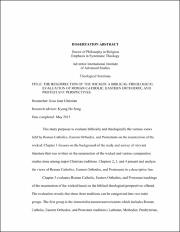The Resurrection of the wicked : a biblical-theological evaluation of Roman Catholic, Eastern Orthodox, and Protestant perspectives
Abstract
This study purposes to evaluate biblically and theologically the various views
held by Roman Catholics, Eastern Orthodox, and Protestants on the resurrection of the
wicked. Chapter 1 focuses on the background of the study and survey of relevant
literature that was written on the resurrection of the wicked and various comparative
studies done among major Christian traditions. Chapters 2, 3, and 4 present and analyze
the views of Roman Catholics, Eastern Orthodox, and Protestants in a descriptive line.
Chapter 5 evaluates Roman Catholic, Eastern Orthodox, and Protestant teachings
of the resurrection of the wicked based on the biblical-theological perspectives offered.
The evaluation reveals that these three traditions can be categorized into two main
groups. The first group is the immortalist-monoresurrectionists which includes Roman
Catholic, Eastern Orthodox, and Protestant traditions (Lutheran, Methodist, Presbyterian,
and Baptist to some extent). This group believes that there is only one single general
resurrection of all the dead at the Second Coming (monoresurrection); the resurrection of
the wicked is a literal bodily resurrection because the soul is immortal, and the
resurrected body of the wicked is changed into immortal and incorruptible in order to
endure endless (immortalist) punishment in the hellfire. This view hardly harmonizes
with Scripture which rather supports the mortalist-polyresurrectionist view, the position
that Seventh-day Adventist comes closer to. This second group believes in a two-phase
resurrection where the resurrection of the wicked is separated from that of the righteous
by a millennium. According to that position, the resurrected wicked with their unchanged
state are simply annihilated by the hellfire that is the second death. Chapter 6 is allocated
for the conclusion of the study with recommendations for further areas of study.


